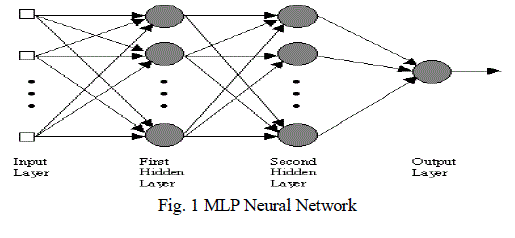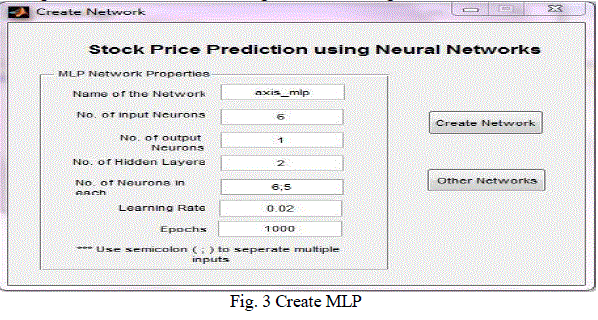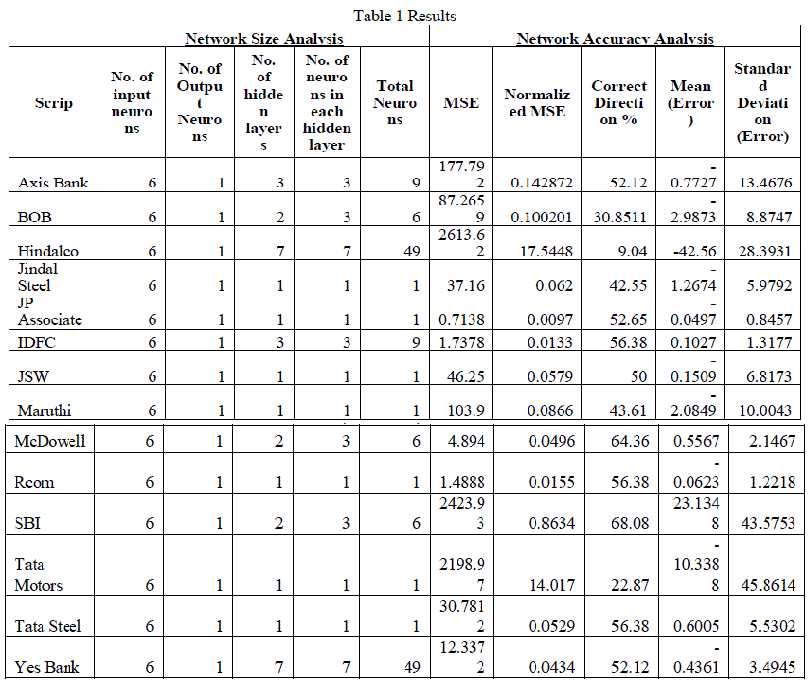ISSN ONLINE(2319-8753)PRINT(2347-6710)
ISSN ONLINE(2319-8753)PRINT(2347-6710)
Mayankkumar B Patel1 and Sunil R Yalamalle2
|
| Related article at Pubmed, Scholar Google |
Visit for more related articles at International Journal of Innovative Research in Science, Engineering and Technology
A stock market is a public market for the trading of company stock. It is an organized set-up with a regulatory body and the members who trade in shares are registered with the stock market and regulatory body SEBI. Since stock market data are highly time-variant and are normally in a nonlinear pattern, predicting the future price of a stock is highly challenging. Prediction provides knowledgeable information regarding the current status of the stock price movement. Thus this can be utilized in decision making for customers in finalizing whether to buy or sell the particular shares of a given stock. Many researchers have been carried out for predicting stock market price using various data mining techniques. This work aims at using of Artificial Neural Network techniques to predict the stock price of companies listed under LIX15 index of National Stock Exchange (NSE). The past data of the selected stock will be used for building and training the models. The results from the model will be used for comparison with the real data to ascertain the accuracy of the model.
Keywords |
| Stock prediction, Neural Network, LIX15 of NSE, Multi Layer perceptron (MLP), MATLAB |
INTRODUCTION |
| From the beginning of time it has been man’s common goal to make his life easier. The prevailing notion in society is that wealth brings comfort and luxury, so it is not surprising that there has been so much work done on ways to predict the markets. Various technical, fundamental, and statistical indicators have been proposed and used with varying results. However, no one technique or combination of techniques has been successful enough. With the development of neural networks, researchers and investors are hoping that the market mysteries can be unraveled. |
| A stock market is a public market for the trading of company stock and derivatives at an agreed price; these are securities listed on a stock exchange as well as those only traded privately. It is an organized set-up with a regulatory body and the members who trade in shares are registered with the stock market and regulatory body SEBI. The stock market is also called the secondary market as it involves trading between two investors. Stock market gets investors together to buy and sell their shares. Share market sets prices according to supply and demand. Stocks that are in demand will increase their price, whereas as stocks that are being heavily sold will decrease their price. Companies that are permitted to be traded in this market place are called “listed companies”. |
| Investors in stock market want to maximize their returns by buying or selling their investments at an appropriate time. Since stock market data are highly time-variant and are normally in a nonlinear pattern, predicting the future price of a stock is highly challenging. With the increase of economic globalization and evolution of information technology, analyzing stock market data for predicting the future of the stock has become increasingly challenging, important and rewarding. Prediction provides knowledgeable information regarding the current status of the stock price movement. Thus this can be utilized in decision making for customers in finalizing whether to buy or sell the particular shares of a given stock. |
| An Artificial Neural Network (ANN), often just called a neural network, is a set of interconnected links that have weights associated with them. The concept of ANN was derived from biological neural networks. Neural networks open up a new foray into the field of making efficient and usable predictions in order to optimize profits. Artificial Neural Networks are being used in numerous areas, as it is an irrefutably effective tool that aids the scientific community in forecasting about probable outcomes. |
| Any ANN can be thought of as a set of interconnected units broadly categorized into three layers. These three layers are the input layer, the hidden layer and the output layer. Inputs are fed into the input layer, and its weighted outputs are passed onto the hidden layer. The neurons in the hidden layer (hidden neurons) are essentially concealed from view. Using additional levels of hidden neurons provides increased flexibility and more accurate processing. However, the flexibility comes at the cost of extra complexity in the training algorithm. Having more hidden neurons than necessary is wasteful, as a less number of neurons would serve our purpose just fine. On the other hand, having less hidden neurons than required would cause reduced robustness of the system, and defeat its very purpose. An illustration of a neural network is shown in Figure 1. |
MLP Neural Network |
| Multi Layer perceptron (MLP) is a feedforward neural network with one or more layers between input and output layer. MLP maps sets of input data onto a set of appropriate outputs. Feedforward means that data flows in one direction from input to output layer (forward). An MLP consists of multiple layers of nodes in a directed graph, with each layer fully connected to the next one. Except for the input nodes, each node is a neuron (or processing element) with a nonlinear activation function. This type of network is trained with the backpropagation learning algorithm. MLPs are widely used for pattern classification, recognition, prediction and approximation. Multi Layer Perceptron can solve problems which are not linearly separable. MLPs separate classes via Hyperplanes. MLPs use distributed learning. MLPs have one or more hidden layers. |
 |
LITERATURE REVIEW |
| Darmadi Komo et al. (1994) used and compared two neural network models, Radial Basis Function (RBF) and Backpropagation (also known as multilayer perceptron (MLP)), for stock market predictions. Actual data of the Wall Street Journal's Dow Jones was used for a benchmark in the experiments. A notable success was achieved with the proposed models producing over 80% prediction accuracies observed based on the monthly Dow Jones Industrial Index predictions. The results demonstrated that the RBF neural network is preferred over the MLP network. |
| D. Venugopal Setty et al. (2010) reviewed the applications of data mining techniques to performance of stock market. The detailed introduction on Indian stock market, information regarding data mining techniques and importance of data mining in prediction field is given. They concluded with there is a growing gap between more powerful storage and retrieval systems. A new technological leap is needed to structure and prioritize information for specific end-user problems. The data mining tools can make this leap. |
| Dase R.K. et al. (2010) did a review of literature on application of Artificial Neural Network for stock market predictions. They found that Predicting stock index with traditional time series analysis was proven to be difficult but an Artificial Neural network may be suitable for this task. A Neural Network has the ability to extract useful information from large set of data. From the past literature, they found that Artificial Neural Network is very useful for predicting world stock markets. They suggested, this is new emerging field and there is considerably large scope for the use of Artificial Neural Network for accurate prediction of stock market index. |
| Akhter Mohiuddin Rather (2011), in his work, used prediction based neural networks approach for stock returns. An autoregressive neural network predictor was used to predict future stock returns. Various error metrics have been used to evaluate the performance of the predictor. Experiments with real data from National stock exchange of India (NSE) were employed to examine the accuracy of this method. Data from date 02-01-2007 till 22-03-2010 for: TCS, BHEL, Wipro, Axis Bank, Maruthi and Tata Steel were taken. The result was not accurate but he suggested the use of better neural predictive systems and training methods for minimizing the prediction errors for the future work. |
| D. Ashok kumar et al. (2013) discussed some basic ideas of time series data, need of ANN, importance of stock indices, survey of the previous works and it investigates neural network models for time series in forecasting. In their study, for performance of between BSE100 stock market index and NIFTY MIDCAP50 stock market index is studied by neural network model and measured aggregation where observed viz., MAE, MAPE, PMAD, MSE and RMSE. The result shows that the performance is comparatively best. From the result they observed that an optimal feedback weighting factor learning rate is 0.28, momentum is 0.5 and epoch is 2960. The model achieved the lower prediction error and it may be fit into any stock market data. |
| Aditya Nawani et al. (2013) discuss how data mining techniques can be applied to design a market capital prediction system for trading firms. Their study shows how neural networks can be utilized, in combination with the Graphical user Interface of MATLAB, GUIDE, to make accurate predictions. When implemented, the trained system can be used to forecast the market capital for a particular combination of input parameters. The accuracy of this method was high because the results obtained were found to be comparable to the output expected. |
OBJECTIVES AND SCOPE |
Objectives |
| • To study the current stock market trend and collect trend data. |
| • To build prediction model for the companies listed under LIX15 index of NSE using multilayer perceptron (MLP) Neural Network technique. |
| • To compare the model with real data for its accuracy. |
Scope |
| • The past three years’ data of the companies listed under LIX15 index of NSE are used for building, training and testing the prediction model for MLP algorithms. |
PROPOSED METHODOLOGY |
| Step 1: Data collection- past data of stock market are collected from various authorized sources. |
| • The data of companies listed under LIX15 index of NSE, for the duration of 36 months (1-1-2011 to 1-1- 2014) have been collected. |
| Step 2: Developing MLP neural network algorithm to predict future stock price. |
| With Neural Network Toolbox MATLAB, MLP neural network is built and trained for different combinations of data and parameters as shown in below snapshots. |
| • Once the program is run, the GUI appears as shown below. |
 |
 |
 |
| Here, actual value is compared with the predicted value. In the output curve as shown in Fig. 7, blue line shows actual value for that particular input index and red line shows predicted value. |
RESULTS |
| For different combinations of data and parameters, the different results and outputs are taken for all the companies that are listed under LIX15 Index of NSE. |
 |
 |
| Performance analysis is the most important part. The numbers here are very deceptive and careful analysis of the same is important. |
| MSE: Mean Square Error is obtained by squaring the difference of obtained output and the actual output. The main drawback of MSE is that the value of MSE increases with the increase in the stock price. Eg: Assume that a neural network is able to predict the price with 90% accuracy. For stock like Idea cellular whose price is in the range of 150-200 the maximum possible MSE is 400. If the same network is used for Infosys whose price is in the range of 2000 - 3000 the maximum MSE is around 90,000. Hence MSE is a very deceptive number. It is used by the system for training the weights. |
| MSE various with stock price hence cannot be used for comparison. We need a number which can be compared, for this Normalized MSE is the solution. Normalized MSE is obtained by dividing MSE with the stock price. Correct Direction %: Let us assume that the actual closing price of the stock is 100 Rs even if the predicted price is 99.9999 Rs it is not accounted in the above percentage. Hence correct direction % should alone not be used for the analysis. It is used along with the normalized MSE for comparing neural networks. Standard Deviation is used for identifying the range for the accuracy of the network. It is used along with Correct Direction %. Thus, Normalized MSE along with Correct Direction % and SD are used for comparing performance of the system. |
CONCLUSION |
| Stock market data are highly time-variant and are normally in a nonlinear pattern, predicting the future price of a stock is highly challenging. Prediction provides knowledgeable information regarding the current status of the stock price movement. In the literature review, different data mining techniques for stock market prediction are reviewed. It is noticed that Artificial Neural Network technique is very useful in predicting stock indices as well as stock price of particular company. Many different algorithms have been used with neural network. Feedforward MLP neural network technique is considered to predict the stock price of companies listed under LIX15 index of NSE. From the result table is can be concluded that MLP neural network technique gives the satisfactory output with |
| Median Normalized Error 0.05995 |
| Median Correct Direction % 51.06 |
| Median Standard Deviation 6.39825 |
References |
|